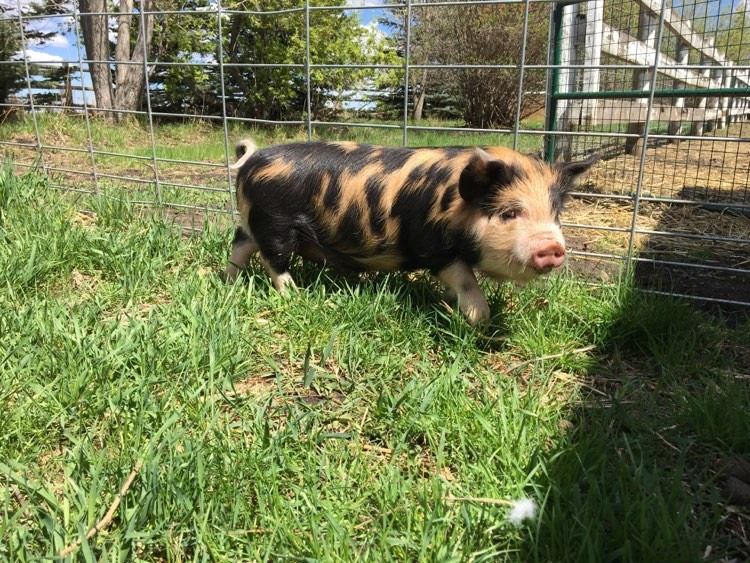Feeding your pigs
WHO
- You are responsible for ensuring pigs are provided proper nutrition and quantity of feed and water on a daily basis.
- You are responsible to ensure their diets do not contain meat or meat products. It is possible for these products to give your pigs a disease. It is also an illegal practice under the federal Health of Animals Regulations; this includes all pet foods that contain meat or meat by-products and food waste containing meat. Requirements – Small Scale Pig Farming
WHAT
- Pigs can be raised on a variety of feeds, as long as the nutritional requirements for various stages of production are met. It is important to note that pigs cannot be raised on pasture alone and will require additional feed for proper growth and development. There are several options to consider when feeding your pigs. Feeding Your Pigs – Small Scale Pig Farming
WHERE
- While the type of feeder you can use to feed your pigs can vary, the proper placement of the feeder can alleviate additional work and stress (for pigs and people) associated with feeding your pigs. The first and most important step is to ensure feeders are easily accessible to all pigs and located in a position where contamination will be minimized. Feeding Your Pigs – Small Scale Pig Farming
WHEN
- Pigs need to be fed everyday, with the amount of feed they require being dependant on their breed, age, sex, stage of growth, condition, and type of ingredients used. Typically, sows and boars are fed once or twice per day, while growing pigs would ideally have access to feed 24 hours a day.
WHY
- Poorly balanced or nutritionally inadequate diets (especially in energy) not only result in higher feed intake but can result in pigs that get sick more easily, grow slowly, convert feed inefficiently, and produce a poorer quality carcass (too fat and/or low muscle mass).
- As pigs cannot be raised on pasture alone, the amount of feed provided will need to be adjusted to the age and size of pigs. Pigs raised outdoors require more feed, particularly in colder weather, to maintain their body temperature.
Fencing
- Fencing is a critical factor in raising pigs. You should give strong consideration to your fencing options prior to bringing pigs home, as pigs can be escape artists. Escaped pigs can form wild populations that heighten other pig farms’ disease risk.
- Fencing provides a barrier to keep pigs within a specific area, in addition to keeping predators and unwanted visitors out. Pigs will root or dig under a fence that is not properly designed.
- It is important to monitor and maintain fences, specifically looking for weak spots when using page wire, wooden, or mesh fences, and ensure proper grounding of electric fences to avoid electrical shorts.
- If using an electric fence for your pens, it is recommended to also have an outer perimeter fence to protect your pigs from predators and other wildlife.
- Double-layered fencing, such as electric fenced pens within a larger perimeter fence, can also help prevent nose-to-nose contact with wildlife that can put your pigs at risk of contracting a disease.
- Fencing – Small Scale Pig Farming
Housing and Shelter
- Proper housing is one of the most important components in raising pigs. Shelters can be simple to complex in nature but must provide pigs protection from adverse weather conditions – cold protection in the winter and heat/ sunburn protection in the summer. Pigs will require additional bedding throughout the winter and shade and water to cool off in the summer.
- Pigs can be raised in a number of ways, including 100% outdoor (pasture) production, a small barn, or a combination of indoor/outdoor production. The type of shelter will depend on how you choose to raise pigs and the resources available to you.
- Options for shelters include a well-constructed shed, arch, hoop structure, small barn, or large (round) bales arranged in a circle. Regardless of the type of shelter you choose, it is essential to provide pigs protection from adverse weather.
- Housing & Shelter – Small Scale Pig Farming
Water
- A pig’s water intake will be 2–3 times higher than feed intake. Pigs require water continuously (24/7) to grow to their best potential. Water can be delivered in several ways, including a trough, tub, nipple drinker, or water bowl. However, surface water should not be used as a water source for your pigs, as it can attract rodents and birds and become contaminated. Keep in mind the goal is to provide fresh, clean water at all times. Therefore, the system you choose will depend on water source, number of pigs, pasture/penning layout, and season (winter requires preventative measures to avoid freezing).
- Water quality is essential. When using tubs or troughs, ensure they are cleaned on a regular basis to avoid contamination from manure. You should also consider testing your water (from the drinking source) annually, in addition to regular chlorination, to avoid risks associated with fecal coliforms.
- Water – Small Scale Pig Farming
